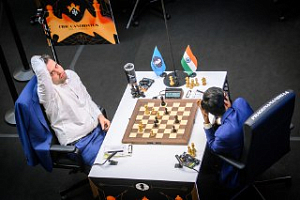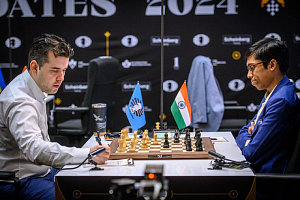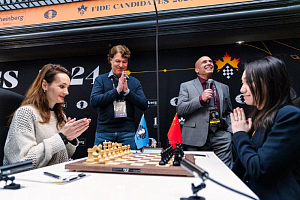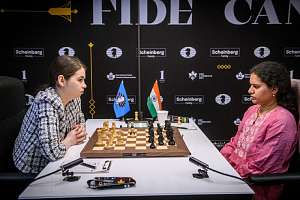13 September 2015
The Gallery Still Fills Up
Vladimir Barsky reviews the Round Seven of the Junior U20 Championship in Khanty-Mansiysk.
The Polish grandmaster Jan-Krzysztof Duda became a sole leader, winning his fourth game in a row.
Van Foreest – Duda
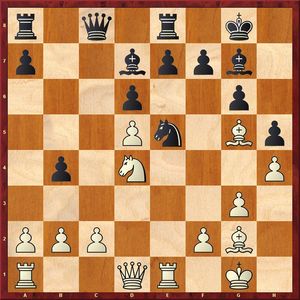
Although the position is approximately equal, Black has an easy game as he grabbed space on the queenside and has something to hook up to on this part of the board. The Dutch junior made up his mind to simplify the situation.
17.a3 Rb8 18.axb4 Rxb4 19.Nc6
White must have believed that multiple piece trades is the most direct way to make a draw. However, he failed to take into account that black pieces would develop a high level of activity.
19…Bxc6 20.dxc6 Rxb2 21.Rxa7 Nxc6 22.Bxc6 Qxc6 23.Raxe7 Rxe7 24.Bxe7 Bc3!
In the case of 24...Rxc2 25.Qxd6 it is indeed high time that the players signed a peaceful agreement. This intermediate move, however, changes the evaluation of the position.
25.Qc1?
This cute attempt fails nonetheless. White can no longer go on retaining the material balance as 25.Re3 Be5 26.Re2? runs into 26…Qb7! with the double threat against е7 and b1, therefore the best way to complicate the Black’s task was worth starting to contemplate about. Instead of 26.Re2? stronger is 26.Qf3 Qxc2 27.Kg2, and Black will find it difficult to start rolling his extra pawn forward.
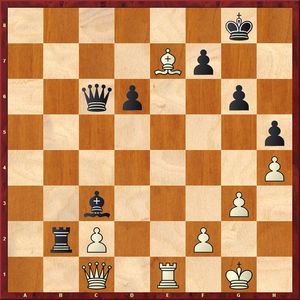
25...Rb7! 26.Qh6 Qe8 27.Re3 Rxe7 28.Rxc3
Although White has managed to keep his c2 pawn alive, too high a price has to be paid for it as his pieces are scattered all over the board and offer poor protection for his king. Black launches a decisive assault.
28…Re1+ 29.Kg2 Qe4+ 30.Rf3
This is quite a modest role for the rook, but there is nothing else left to do.
30…Qe2! 31.Re3 Qf1+ 32.Kf3 Qh1+ 33.Kf4 Qg2
Black was winning nicely after 33...Rxe3 34.fxe3 (34.Kxe3 runs into an X-ray shot 34…Qc1+) 34...Qf1+ 35.Ke4 Qd1!, and White has no reasonable protection against the threat of 36…f5+.
34.Rxe1 Qxf2+ 35.Ke4 Qxe1+ 36.Qe3
The pawn ending without a pawn is as hopeless as the queen ending being two pawns down.
36…Qxe3+ 37.Kxe3
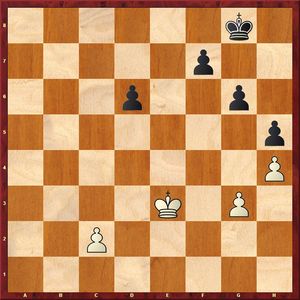
37…f6 38.Ke4 Kf7 39.Kd5 Ke7 40.c4 g5 41.Kd4 Ke6 42.Ke4 f5+ 43.Kd4 g4 White resigns.
Grigoryan – Bajarani
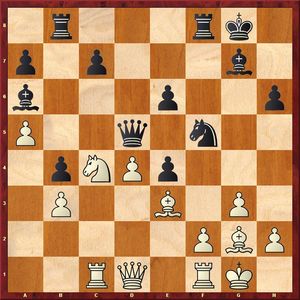
Black played the opening in a very risky manner, having created himself a lot of pawn weaknesses, whereas the activity of his pieces only partly compensates for these permanent positional shortcomings. After the accurate 23.Re1! (unpinning the knight on c4) 23...Nxd4 24.Nd2 the pawns on c7 and e4 become exposed, and Black would have been in for a difficult defense. However, White committed an error.
23.Qg4? h5!
This stab is quite unpleasant! The h5-pawn cannot be taken in view of 24.Qxh5? Nxe3, leaving White down a piece. The е4-pawn is not up for grabs either: 24.Qxe4?! Qxe4 25.Bxe4 Nxd4 26.Bxd4 (the bishop has to be traded because 26.Rb1 is met by 26…Nxb3) 26...Bxd4 27.Kg2 Rbd8, and Black’s position is very active. Therefore, the queen has to retreat.
24.Qe2 Rf7 25.Qc2 Nxd4 26.Bxd4 Bxc4?!
Correct is 26...Bxd4 27.Bxe4 Qg5, and the resulting position is in Black’s favor.
27.Bxa7?
White returns the favor. Perhaps after 27.Bxe4 Qxd4 28.Qxc4 Qxc4 29.Rxc4 White would not have succeeded in winning this ending, but could have subjected his opponent to considerable torments.

When taking the a7-pawn, White must have counted on 27…Bxb3, at which moment the move 28.Bxe4! would have allowed him taking over the initiative. The Azeri GM, however, had an unpleasant surprise prepared for his opponent.
27...Bd3! 28.Qc6 Ra8 29.Be3 Bc3
The black bishops have mastered the entire board! The ending arising after the trade of queens is hopeless for White as he loses both а5 and b3 pawns. Each of the menacing bishops has to be traded for a rook.
30.Rxc3 bxc3 31.Qxc3 Bxf1 32.Bxf1 Rxa5
And Black went on to convert his double exchange advantage.

33.Bc4 Qd1+ 34.Kg2 Ra1 35.Be2
35.Qe5 is decisively met by 35…Qf3+ 36.Kh3 Qf5+ 37.Qxf5 exf5.
35...Qh1+ 36.Kh3 Rg1 37.Bxh5 Qg2+
Black could launch a decisive direct attack by 37...Rf5 38.Bg4 (38.Be2 Qg2+ 39.Kg4 Qxh2 40.Bg5 Rh1 does not allow to escape either) 38...Qg2+ 39.Kh4 Qxh2+ 40.Bh3 Rh1, etc.
38.Kg4 Qf3+ 39.Kh4 Qf6+ 40.Qxf6 Rxf6 41.Kg5 Rf5+ 42.Kg6 Rg2 43.Bg4 Rgxf2 White resigns.
Murali – Antipov

In this roughly equal endgame (the black rook is more active than White’s, but the knight is stronger than the bishop) White decided to dispatch his rook into an attack.
32.Rh1
32.c4 Rb2 33.Rh1 is a fool-proof path to a draw, for example, 33…Rxb3 34.Rh7 f6 35.Rh8 Kd7 (after 35...Bb6? 36.Rc8+ Black is left down a piece) 36.Rh7+ Kc6 with a repetition of moves. It is not to be ruled out, however, that White was not striving to a draw at that moment.
32...Rxc2 33.Rh7 Rb2 34.b5+?
Here after 34.Rxf7 Rxb3 35.Rf8 Bb6 36.Rc8+ (36.Rf5 Bd8 37.Rf8) 36...Kb5 37.Rb8 Black would have to accept a drawish outcome.
34...Kxb5 35.Rxf7 Ba5 36.Rxb7+ Kc5 37.Ra7 Be1+ 38.Kh3 a5 39.Rc7+ Kd4
The active position of his king gives Black excellent chances for a victory.
40.Rc6 Rxb3 41.Kg2 Rb2+ 42.Kh3
42.Kg1 Kd3 43.Rxd6 Ke2 or 42.Kf1 Bb4 would have been no better.
42...Bb4 43.Nxb4 axb4 44.Rxd6+ Ke3 45.Re6

45…Kf2!
A beautiful game around White's king ensues, where Black is assisted by the opponent’s g4-pawn, which restricts the white king.
46.Rxe5 Rb1 47.Kh2 Rd1! 48.Rxg5 Rd8 49.Rh5 b3 50.Kh1 Kg3 White resigns.
The following 12-move game should take its rightful place in the gallery named after Anatoly Matsukevich.
Galoyan – Makarenko
1.e4 e5 2.Nf3 Nc6 3.d4 exd4 4.Nxd4 Qh4
Although this line of the Scotch game, favorite of Steinitz, is considered dubious nowadays, White turned out to be unprepared for it.
5.Qd3 Bc5 6.c3 Nf6 7.Nd2 Ng4 8.g3 Qf6 9.f3 Bxd4
This is the beginning of the wrong combination. Although 9...Nge5 10.Qe3 0–0 give Black an advantage, the game would never end that quickly.
10.cxd4 Nb4 11.Qc3 Ne3

12.Kf2??
These knights, jumping all over the board and flickering before your eyes, annoyed Susanna Galoyan to commit a blunder.
12...Nd1+ White resigns.
Meanwhile, in the position on the diagram White is still able to ward off all threats, remaining up a piece: 12.Bd3! Qxd4 13.Ke2! or 12...Nxd3+ 13.Qxd3 Qxd4 14.Ke2! It’s time that we recalled Steinitz once again who said that king itself is a strong piece!


















